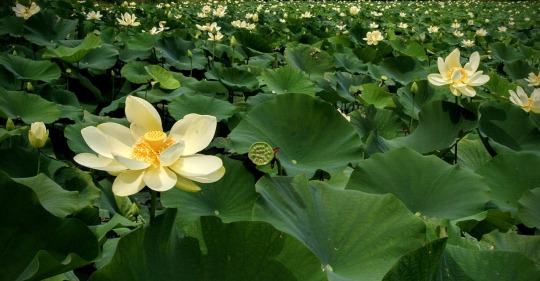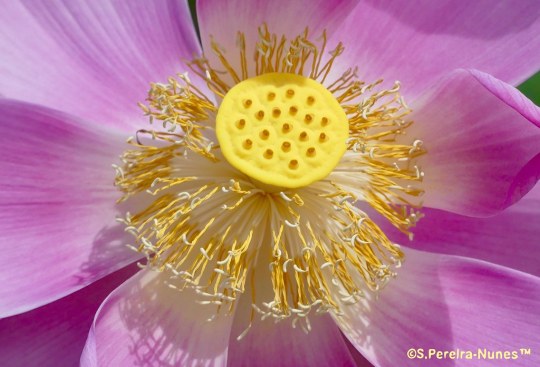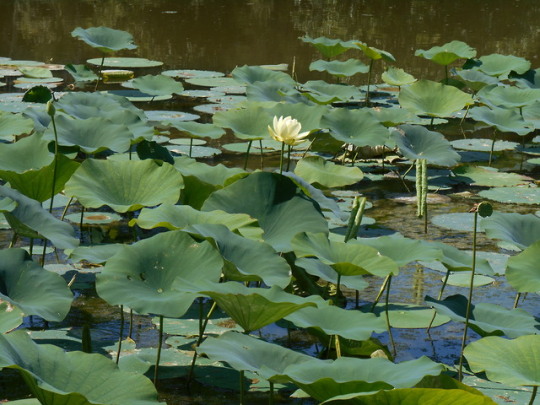#nelumbonaceae
Text

Did you know North America has a native lotus? Nelumbo lutea or yellow lotus is one of only two wild lotus species left on the planet. This prehistoric giant produces the largest flower in North America - the size of your head! The leaves average two feet across. It grows from the Great Lakes down to Central America and the Caribbean. It is edible, medicinal, mildly poisonous, and mildly psychoactive. Many Native American tribes believed it had mystical powers.
More info:
• Native American Ethnobotany Database
• Plants for a Future Database
• Wikipedia
Photo from Wikimedia Commons
#bane folk#lotus#yellow lotus#american lotus#nelumbo lutea#nelumbonaceae#sacred lotus#ancient plants#prehistoric plants#north america#ethnobotany#poisonous plants#medicinal plants#edible plants#psychoactive plants
210 notes
·
View notes
Text
Language of Flowers: Lotus Plant
Every day has its designated flower in the language of flowers. The flower for today, November 10, is the Lotus Plant, which signifies eloquence.
Image above from Wikipedia.
Nelumbo nucifera, also known as Indian lotus, sacred lotus, bean of India, Egyptian bean, or simply Lotus, is one of two extant species of aquatic plant in the family Nelumbonaceae. It is often colloquially called a water…

View On WordPress
#birthday#Egyptian bean#Language of flowers#Lotus Plant#Nelumbo#Nelumbo nucifera#Nelumbonaceae#november
0 notes
Note
Love that you gave Nezha a cat. They’re so cuteeeeeeeee
Also the cat looks so fluffy does it have a name
gosh that was from my old blog...
I think he named her after a flower? probably Nelum (short for Nelumbonaceae, the flower family of the lotus-lilies)
but yes she's a sweetheart
(and a gift from a certain monkey god)
23 notes
·
View notes
Photo

Ellis Rowan “Nelumbo nucifera Gaertn, family Nelumbonaceae, Herbert River, Queensland“ 1887 watercolour 54.8 x 38 cm.
24 notes
·
View notes
Text

Sacred lotus
plant
Also known as: Indian lotus, Nelumbo nucifera
Article History
Sacred lotus, (Nelumbo nucifera), also called Indian lotus, attractive edible aquatic plant of the lotus-lily family (Nelumbonaceae) found in tropical and subtropical Asia. Representing spiritual enlightenment, the flower is sacred in both Hinduism and Buddhism and was used in ancient Egypt to represent rebirth. The sacred lotus has a superficial resemblance but a distant relationship to the water lilies (family Nymphaeaceae).
By Encyclopaedia Britannica
🪷🪷🪷🪷🪷🪷
2 notes
·
View notes
Photo

Nelumbo nucifera, also known as #Indianlotus #sacredlotus or simply #lotus, is 1 of 2 extant species of aquatic plant in the family Nelumbonaceae. The #lotusflower also represents the path to spiritual #awakening and #enlightenment. I also find it fascinating that these flowers open up in the morning & then close back up at night. So cool. #ilovenature ~ #lillypads #pond #flower #beautifulflowers #rebirth #transformational #lotusflowers #flower #flowers #flowerphotography #flowerphoto #buddhism #buddhist #lotussutra #flowerlife #flowerlove #flowerlover #flowerlovers #nature #naturelovers #naturephotography #flowersofinstagram #flowerpower #floweroftheday https://www.instagram.com/p/CexRGkRLi0s/?igshid=NGJjMDIxMWI=
#indianlotus#sacredlotus#lotus#lotusflower#awakening#enlightenment#ilovenature#lillypads#pond#flower#beautifulflowers#rebirth#transformational#lotusflowers#flowers#flowerphotography#flowerphoto#buddhism#buddhist#lotussutra#flowerlife#flowerlove#flowerlover#flowerlovers#nature#naturelovers#naturephotography#flowersofinstagram#flowerpower#floweroftheday
2 notes
·
View notes
Text
Cây Hoa Chữa Bệnh - HOA SEN
Tên khác: Liên, Ngẫu (Tày), Bó pua (Thái). Lim ngó (Dao).
Tên khoa học: Nelumbo nucifera Gaertn [Nelumbium nelumbo (L.) Druce]. Họ Sen (Nelumbonaceae).
Nguồn gốc:
Cây Sen nguồn gốc châu Á lục địa. Hoa Sen là vật linh thiêng tượng trưng của, Ấn Độ giáo và Phật giáo, tương tự như họa Sen Ai Cập, hoa trắng (Nymphea lotus) là hoa linh thiêng của Ai Cập.
Cây Sen được trồng từ lâu đời ở Việt Nam; Sen được trồng ở nhiều nơi để ăn, làm mứt, làm thuốc, làm cây cảnh. Có hai giống Sen được trồng phổ biến: 1) Sen hồng, cao, khoẻ, hoa màu hồng, to, thơm; 2) Sen trắng, cây cao, hoa trắng, yếu hơn. Ngoài ra còn trồng Sen sẻ, cây thấp hoa bé, thường trồng trong bể, trong chậu. Sen được trồng bằng mầm, ngó Sen. Trồng vào giữa mùa xuân, thời tiết ấm; trồng xong cho nước vào ao, hồ từ từ cho ngập đến 2/3 thân cây, giữ mực nước như vậy khoang 3 - 4 tháng, Mùa hè năm sau cây ra hoa; mùa đồng cây tàn, mùa xuân lại mọc.
…
NguyênLiệuLàmThuốc #CầmMáu #ChữaĐiLỏngĐauBụng #ChữaNamKhoa #ThuốcNgủAnThầnTrấnKinh #ThuốcBổBồiDưỡng
0 notes
Text

The oldest direct evidence of water lilies being used as a psychoactive drug dates to 6,000 BCE in ancient Egypt. The specific species was Nymphaea nouchali var. caerulea which has been found to contain nuciferine, an alkaloid normally found in lotuses (Nelumbonaceae), as well as other aporphine alkaloids that may covert to apomorphine in the body. Water lilies are soporific aka hypnotic. Hypnotic herbs are anti anxiety and help people fall asleep and stay asleep.
Source: “The oldest archeological data evidencing the relationship of Homo sapiens with psychoactive plants,” Journal of Psychedelic Studies, 2019.
Photo: Egyptian blue water lily (Nymphaea nouchali var. caerulea) from Wikimedia Commons.
#bane folk#blue lotus#Egyptian blue water lily#water lily#nymphaea#nymphaea caerulea#nymphaea nouchali var caerulea#nymphaeaceae#medicinal plants#poisonous plants#edible plants#psychoactive plants#soporific#hypnotic#sedative#folk medicine
12 notes
·
View notes
Text
Tiểu luận: Hoa Sen Biểu tượng văn hóa của Việt Nam
Chia sẻ đề tài Tiểu Luận: Hoa Sen Biểu tượng văn hóa của Việt Nam cho các bạn đang chuẩn bị làm bài tiểu luận cùng nhau tham khảo nhé. Tiểu luận môn học là một trong những yêu cầu bắt buộc của các trường đại học, và Cao Học. Đối với sinh viên hay học viên tất cả các khóa học đều bắt buộc phải làm một bài tiểu luận, với đề tài bắt buộc hoặc là một đề tài cụ thể nào đó ví dư như đề tài: Tiểu Luận: Hoa Sen Biểu tượng văn hóa của Việt Nam các bạn cùng tham khảo đề tài tiểu luận dưới đây nhé.
Tồn tại từ ngàn năm cùng với cây cỏ thiên nhiên đất nước, hoa sen không chỉ là người bạn thân thiết mà còn được xem như là biểu trưng văn hoá bén rễ sâu trong tâm thức người dân Việt.
Hoa sen có tên khoa học là Nelumbonaceae, thuộc loài túc thảo, môi trường sống tự nhiên của hoa sen ở vùng đầm lầy, ao, hồ nông hoặc ở vùng sâu ngập nước. Theo các nhà khoa học, sen đã có mặt trên trái đất khoảng từ gần 100 triệu năm trước. Hiện nay trên thề giới còn hai loại sen hoa vàng (Nelumbonaceae Pers) có ở miền Bắc và miền Trung Châu Mỹ và hoa sen đỏ ( Nelumbo Nucifera Gaertn) mọc phổ biến nhiều nước Châu Á và Châu Úc. Mùa hè là mua sen nở và hương sen dịu nhẹ có thể thoảng trong gió bay xa đến vài trăm mét. Ở Việt Nam, sen được xếp vào bộ tứ quý ( 4 mùa): Lan, sen, cúc, mai và xếp vào hàng “tứ quân tử” cùng tùng, trúc, cúc.
https://vietluanvanluat.com/tieu-luan-hoa-sen-bieu-tuong-van-hoa-cua-viet-nam/
Hoa sen rất thích hợp với môi trường có khí hậu nhiệt đới như nước ta. Từ Bắc vào Nam, nó có mặt khắp mọi nơi, gần gũi và thân thiết với mọi người như cây tre, cây đa. Nếu ở miền Bắc, hoa sen chỉ nở vào mùa hè, thì ở hầu khắp miền Nam quanh năm đâu đâu cũng thấy sen khoe sắc thắm, đặc biệt ở vùng Đồng Tháp Mười:
CÓ THỂ BẠN QUAN TÂM ĐẾN DỊCH VỤ:
===>>> Dịch Vụ Viết Thuê Tiểu Luận Môn
Tháp Mười đẹp nhất bông sen
Việt Nam đẹp nhất có tên Bác Hồ
Trong lòng mỗi người dân Việt, sen là loài hoa tượng trưng cho vẻ đẹp tươi sáng, cao sang và thuần khiết mang tính chất dân tộc. Chính vì thế, hoa sen luôn là nguồn cảm hứng bất tuyệt của thi ca và nghệ thuật... Có lẽ, không người Việt Nam nào không thuộc bài ca dao đầy tính triết lý này: “Tiểu Luận: Hoa Sen Biểu tượng văn hóa của Việt Nam”
Trong đầm gì đẹp bằng sen
Lá xanh bông trắng lại chen nhuỵ vàng Nhuỵ vàng bông trắng là xanh
Gần bùn mà chẳng hôi tanh mùi bùn
Người Việt đã cảm nhận được ý hay “Gần bùn mà chẳng hôi tanh mùi bùn”, sen sống trong bùn nhưng sen vươn lên trên lầy, toả hương thơm ngát. Sen có một sức sống mạnh mẽ đến kỳ lạ và tự tính của sen là tinh khiết, vô nhiễm. Nó tượng trưng cho bản tính thân thiện, phong thái tao nhã, tinh thần “vươn dậy” trong mọi nghịch cảnh của con người Việt Nam. Đặc biệt trong tư tưởng Phật giáo, hoa sen được tôn quý và chiếm vị trí rất quan trọng. Tinh thần “cư trần bất nhiễm trần”, đó cũng chính là ý nghĩa của hoa sen biểu trưng cho những giá trị đạo đức, sự thuần khiết và thánh thiện, sự duy trì và phát triển của Phật pháp, trí tuệ dẫn đến niết bàn. Trong các công trình kiến trúc Phật giáo ở Việt Nam, sen luôn trở thành hình tượng nghệ thuật. Một trong những công trình kiến trúc tiêu biểu lấy cảm hứng từ hoa sen là chùa Một Cột. Theo truyền thuyết, ngôi chùa này được hình thành từ một giấc mộng đài sen của vua Lý Thái Tông. Cảm hứng từ mộng là loại tâm lý nghệ thuật của các dân tộc phương Đông. Chùa có hình dáng hoa sen, mọc lên từ hồ nước, chỉ với “một cột” một cọng sen. Ở đây, hoa sen là sự giác ngộ, đạt được sự trong sáng và giải thoát khỏi bùn nhơ...
Không chỉ vậy, hoa sen còn gắn bó và hiện diện trong đời sống hàng ngày của người dân Việt: Tâm sen dùng để ướp thuốc, hương sen dùng để ướp chè, ngó sen dùng để làm món ăn, lá sen cũng dùng để gói bánh, gói cốm và nó mang lại mùi thơm đặc biệt. “Tiểu Luận: Hoa Sen Biểu tượng văn hóa của Việt Nam”
1 note
·
View note
Photo

Nelumbo nucifera, also known as sacred lotus, Laxmi lotus, Indian lotus, or simply lotus, is one of two extant species of aquatic plant in the family Nelumbonaceae. It is considered sacred in Eastern cultures.
due to popular demand, the UNCENSORED VERSION IS NOW PUBLIC!
THIS HAS NS/FW, YOU MUST BE 18+ TO VIEW.
[imgur link to view]
107 notes
·
View notes
Photo

A closeup in the flower of lotus, water-lily, Suriname by Sebastiao P Nunes https://flic.kr/p/2kMLutM
11 notes
·
View notes
Photo





American lotus at Adams Lake
40 notes
·
View notes
Photo


This year was a disappointing one for lotuses. The bayou wasn’t covered with them like last year. Not sure the factors that had a hand in it.
#American lotus#yellow lotus#water-chinquapin#volée#Plantae#Angiosperms#Eudicots#Proteales#Nelumbonaceae#Nelumbo#Nelumbo lutea#Nikon D3400#nikonphotography#my flora#nature photography#photographers on tumblr#Black Bayou Lake National Wildlife Refuge#freshwater plants#flora of North America#Pre-Columbian Great Plains cuisine#rhizomatous plants#flora
3 notes
·
View notes
Text

Antinous: Festival of the Red Lotus
In August 22, the modern cult of Antinous celebrates the Festival of the Red Lotus, which is said to have sprung from the blood of the Marousian Lion hunted by Antinous and Hadrian.
The white and blue flowers native to Egypt and described as “lotus” in ancient Egyptian mythology and art are actually water lilies, members of the genus Nymphaea. Blooms of the blue Egyptian water lily Nymphaea caerulea open and close during daylight hours; the white Egyptian water lily Nymphaea lotus opens at dusk and closes in the mid-morning. Folk tales describe the flowers as rising from the water at dawn or dusk each day, but rather the buds form underwater and emerge above the water as the stems lengthen, open and close each day during the few days of bloom, and then sink beneath the water after the period of bloom is finished. The sinking below and rising above the water links the “lotus” with the mythology of rebirth.
The red Egyptian lotus Nelumbo nucifera is a member of the family Nelumbonaceae. Native to India, East Asia, and Southeast Asia. It seems to have been brought to Egypt in the Late Period, in the 6th or 7th centuries BCE. Its appearance is very different to the blue and white lilies, with rounded petals rising well above the water.
It is this flower which legend associates with Antinous. A poem from the reign of Diocletian (284 – 305 CE) links the Lion Hunt with the lotus:
The nymphs began to crown their tresses
With the flower named after Antinous,
Which to this day preserves
The mighty spear of the hunter.
Into the Nile he hurried for purification
Of the blood of the lion…
– Payprus Oxy. 63.4352 (X)
Another text from the 3rd century CE specifically mentions the color of the lotus of Antinous:
But since I have mentioned Alexandria, I know that in that beautiful city there is a garland called the garland of Antinous, which is made of the lotus, which grows in those parts. And this lotus grows in the marshes in the summer season; and it bears flowers of two colours; one like that of the rose, and it is the garlands woven of the flower of this colour which are properly called the garlands of Antinous; but the other kind is called the lotus garland, being of a dark colour. And a man of the name of Pancrates, a native poet, with whom we ourselves were acquainted, made a great parade of showing a rose-coloured lotus to [H]adrian the emperor, when he was staying at Alexandria, saying, that [p. 1082] he ought to give this flower the name of the Flower of Antinous, as having sprung from the ground where it drank in the blood of the Mauritanian lion, which Hadrian killed when he was out hunting in that part of Africa, near Alexandria; a monstrous beast which had ravaged all Libya for a long time, so as to make a very great part of the district desolate.
– Athenaeus. The Deipnosophists. Or Banquet Of The Learned Of Athenaeus. London. Henry G. Bohn, York Street, Covent Garden. 1854. (X)
Ave, ave Antinoe! The red lotus reminds us of your courage. May we, too, rise after the struggles of life, and join you in the company of the immortals!
https://honorthegodsblog.wordpress.com/2018/08/22/antinous-festival-of-the-red-lotus/
2 notes
·
View notes
Video
Nelumbo nucifera is the species of lotus that has historical, cultural and spiritually significant in Indian subcontinent. It is a sacred flower in both Hinduism and Buddhism #nelumbonucifera #indianlotus #sacredlotus #aquaticplant #nelumbonaceae #buddhism #hinduism #purity #englightment #rebirth #regeneration #edibleroots #leaves #perinial #gardening #gardenstories #runwithkiran #horticultrist #pixelclicks #landscapephotography #mobilephotography #horticulture #gardensofinstagram https://www.instagram.com/reel/CS67wo0Bgt-/?utm_medium=tumblr
#nelumbonucifera#indianlotus#sacredlotus#aquaticplant#nelumbonaceae#buddhism#hinduism#purity#englightment#rebirth#regeneration#edibleroots#leaves#perinial#gardening#gardenstories#runwithkiran#horticultrist#pixelclicks#landscapephotography#mobilephotography#horticulture#gardensofinstagram
0 notes